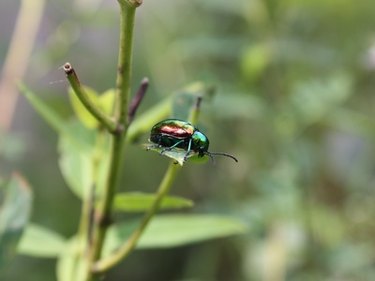
True grubs tend to be referred to as "white grubs" and are the larval stage of certain beetle species such as Japanese and June beetles. You may encounter brown pests in your garden that have the same physical characteristics of true grubs: a thick, worm-like body that curls into a C-shape. In fact, true white grubs may have a brown head or even a brown body. Grubs tend to destroy the roots and stems of garden plants. When they reach the adult stage, they munch and destroy plant foliage.
Japanese Beetle Larvae
Video of the Day
Japanese beetle grubs may be light brown, white or gray. In all cases, the heads of these grubs are brown. Japanese beetle grubs are approximately 1 inch long and assume the curled C-shape form when startled. They start feeding on roots and stems in your garden and lawn in midsummer and the following spring before developing into pupae. If you see Japanese beetles around the base of plants, you can hand-pick them. Other control methods involve removing leaves and other debris around garden beds, purchasing insect-eating nematodes from your local nursery and releasing them in your garden, or applying a natural pyrethrum spray. By controlling the larval stage of Japanese beetles you can prevent the adults from further attacking plant foliage. Just in case, plant impatiens, pansies and other Japanese beetle-resistant flowers.
Video of the Day
Cutworms
Cutworms are the larval stage of owlet moths, in the noctuidae family of moths. The C-shaped cutworms, up to 2 inches long, may be brown, but also green, tan, gray or black. They not only attack roots and stems, but also climb up to feed on the leaves of plants. Cutworms are most damaging in the spring. Owlet moths tend to lay their eggs in weedy areas or places with leaf debris. By removing weeds and cleaning up garden beds regularly, you can prevent a cutworm infestation. Vigorously till and weed your garden in early spring before planting to kill any cutworm larvae that may be overwintering in the ground. If you suspect a cutworm infestation, make collars out of cardboard, aluminum foil or plastic and place them around plant stems to prevent damage.
Pepper Weevil Larvae
Pepper weevils are present in the southern United States. Although the larval bodies are white or light gray, they have heads that are brownish-orange. Pepper weevil larvae are small, measuring approximately 1/5 inch when fully mature. These grub-like larvae do take on the C-shape form and tend to attack the fruit and pods of the solanaceae (nightshade) family, such as pepper, tomato, eggplant and petunia plants. To control pepper weevil larvae populations, remove any fallen fruit or pods from the ground to discourage them from getting too comfortable in your garden. If larvae develop in adults, you can set up yellow sticky traps.
Leather Jackets
The larvae of craneflies, which look like "daddy-long-legs," are called leather jackets. Leather jackets are grub-like and brown. The larvae tend to attack the roots of turf grass but also may climb to the tops of flowers and herbs in your garden and eat the foliage. Maintaining a healthy lawn through dethatching, aerating and fertilizing and a healthy garden through adding the proper levels of organic material and water, will help plants withstand minor leather jacket invasions. Avoid having any swampy or soggy areas in your garden as craneflies thrive in aquatic environments.
- Harvest to Table: Vegetable Pest Problem Solver
- University of Florida IFAS: Pepper Weevil, Anthonomus Eugenii Cano
- Washington State University Whatcom County Extension: Crane Fly, Leatherjackets
- University of Florida Institute of Food and Agricultural Sciences: White Grubs
- University of Minnesota Extension: Cutworms in Home Gardens
- United States Department of Agriculture: Managing the Japanese Beetle - A Homeowner's Handbook